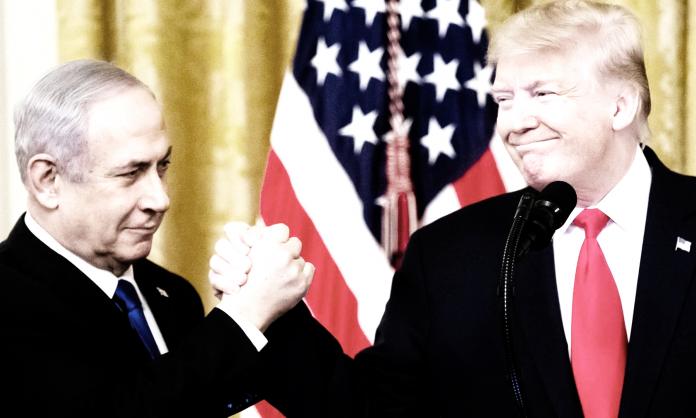US president Donald Trump has released his so-called deal of the century, a Middle East “peace plan” that dictates the terms for a complete Palestinian surrender. By his side at the 28 January announcement stood Israeli interim prime minister Benjamin Netanyahu, who hours earlier had been indicted on charges of bribery and fraud resulting from a series of corruption cases.
Trump’s plan, drafted by advisers of his son-in-law Jared Kushner in close collaboration with Netanyahu, proposes that a series of enclaves spread across the West Bank and Gaza constitute a Palestinian state. The non-contiguous territory would be hemmed in on all sides by Israeli settlements and all the infrastructure of a military occupation.
The plan bears much resemblance to apartheid-era South Africa, when Bantustans (Bantu homelands) were declared independent by the racist state, thereby disenfranchising their Black residents of any civil rights within South Africa. The policy, as Sheena Anne Arackal observes on the news website Mondoweiss, was “the cornerstone of South Africa’s grand apartheid”. It sat side by side with a policy of petit apartheid: racial segregation on buses and public facilities, as well as “pass laws” to restrict the freedom of movement of Blacks.
Trump’s declaration of support for Israel’s territorial ambitions amounts to formal acceptance of Israel’s apartheid policy. Beaming with joy, Netanyahu told a crowd of hard-right Israeli supporters at the Washington launch: “For too long the very heart of the land of Israel, where our patriarchs prayed, our prophets preached and our kings ruled has been outrageously branded as illegally occupied territory. Well today, Mr President, you are puncturing this big lie”.
A smug Netanyahu and his supporters had much to celebrate. The proposal cedes to Israel everything the apartheid state has ever wanted. It calls for Jerusalem, including its old city, to be the “undivided” capital of Israel and declares that the US will recognise Israeli sovereignty over all of Israel’s illegal West Bank settlements, as well as the Jordan Valley – cutting off Palestinian villages from Jordan. Israel will retain security control over territory inside the new Palestinian “state” and will continue to control Palestinian borders, airspace, aquifers and maritime waters.
Without waiting for a Palestinian response to the plan, Netanyahu announced that Israel’s cabinet would vote on annexation of the settlements and the Jordan Valley within a week. Hagai El-Ad, the executive director of Israeli human rights group B’Tselem, described the plan as the imposition of a single, undemocratic state over all of Palestine. He tweeted:
“What the Palestinians are being ‘offered’ now is not rights or a state, but a permanent state of Apartheid. No amount of marketing can erase this disgrace or blur the facts ... The reality on the ground is already one of full Israeli control over the entire area between the Jordan River and the Mediterranean Sea and everyone living in it. It is a reality of one, inherently undemocratic, state.”
Fourteen million people live between the Jordan River and the Mediterranean Sea. Seven million are Palestinian, of whom 5 million are denied citizenship and exercise no rights under Israeli law. Another 2 million Palestinians living inside Israel are subject to a raft of discriminatory laws, including Israel’s racist nation state law, which declares that national rights in Israel belong only to the Jewish people.
**********
Much media commentary on the plan has branded it a “non-starter” and a “departure” from previous efforts by the US, EU and others to broker a peace deal in the Middle East. Prior to the Trump plan, so the story goes, the basic framework for Israeli-Palestinian peace negotiations had been determined by the Oslo Accords negotiated between Israel and the Palestine Liberation Organization (PLO) in 1993.
Under the accords, there would be two states, the Palestinian state exercising control over the West Bank and Gaza Strip, occupied by Israel in 1967, and Israel withdrawing behind the “green line” – the armistice line established after the 1948 Arab-Israeli war. Contentious issues, such as the future of Israeli settlements in the West Bank and the status of Jerusalem, claimed as a national capital by both the state of Israel and the PLO, would be the subject of future negotiations. According to Vox magazine’s Zack Beauchamp, “The Trump plan pretty much throws out this framework entirely”. Yet this analysis fails to grasp the long history of imperialist support for Israel’s colonialist expansion.
In 1917, Britain’s Balfour Declaration declared that Palestine should become a homeland for Jews. During the period of British mandate, following the collapse of the Ottoman Empire, Jews were encouraged to migrate to Palestine, sponsored by the World Zionist Organization. This migration expanded dramatically with an influx of European Jews fleeing Nazi persecution, many of whom were denied refuge by Western governments.
In November 1947, the newly formed United Nations, dominated by Western powers, carved up historic Palestine, dividing the territory between Jewish settlers and indigenous Palestinians. Under the partition plan, Jewish settlers, who made up less than a third of the population and owned less than 7 percent of the land, were given most of the territory. In the war that followed, Zionist militias conquered most of the territory allocated to the Arab state, leading to Israel’s May 1948 declaration of statehood in nearly four-fifths of historic Palestine. Seven hundred thousand Palestinians – 80 percent of Palestine’s Arab population – were made refugees and prevented from returning to their homes. The UN looked on, failing to take action to address the cruel injustice that had befallen the Palestinians.
During the 1967 war, Israel conquered the remaining 22 percent of Palestine, as well as the Sinai Peninsula, previously under Egyptian control, and the Syrian Golan Heights. In the decades that followed, Israel established illegal settlements in the territories it occupied and a regime of separate laws for Israelis and Palestinians living in the same territory. The former were subject to Israeli civilian law and the latter to military law. In 1980, Israel formally annexed East Jerusalem.
While Israel faced international criticism, US financial and military backing strengthened. Israel’s 1967 and 1973 military victories over its Arab neighbours made it a more attractive outpost for US imperial interests in the Middle East. Following the Jordanian monarchy’s suppression of an uprising among Palestinian refugees in 1970 and the defeat of Egypt’s Arab nationalist regime led by Nasser in 1967, Israel’s military power continued to expand, underscoring the Arab regimes’ impotence amid growing US influence in the region.
However, the outbreak of the first Palestinian intifada (uprising) in December 1987 changed the balance of forces. After hundreds of Palestinians witnessed four men being run down and killed by an Israeli jeep outside Jabalia refugee camp in Gaza, a popular revolt erupted. Ten thousand Palestinians attended their funerals. The following day, Israeli troops fired into a crowd, killing 17-year-old Hatem Abu Sisi and wounding others.
Protests rapidly spread across refugee camps in Gaza, the West Bank and East Jerusalem. Palestinians barricaded roads to prevent the Israeli army entering their villages and defended themselves by throwing stones at soldiers and tanks. Palestinian businesses closed their doors and workers withdrew their labour, denying Israel its cheap labour force. Israeli taxes were boycotted.
Over the following four years, Israeli military curfews, home demolitions and beatings and killings of protesters failed to quell the uprising. The PLO leadership, in exile in Tunisia, was sidelined by village-based popular committees that operated in concert with the Unified National Command, composed of representatives from all the Palestinian resistance factions. With no other recourse to end the intifada, Israel was forced to the negotiating table and to recognise the PLO as the representative of the Palestinian people. The PLO leadership, for its part, saw the negotiations as an opportunity to reassert its role.
**********
The outcome of those negotiations was the 1993 Oslo Accords, which granted limited autonomy to Palestinians in the same scattered enclaves now proposed by Trump as the territory of a Palestinian state. The accords made no demand on Israel to dismantle settlements or halt their construction. Indeed, settlement construction continued apace. Western media and governments rejoiced over Oslo. New York Times columnist Thomas Friedman described the accords as an “agreement between Jews and Palestinians to end their conflict” and “a triumph of hope over history”. Within a year, Israeli prime minister Yitzhak Rabin, PLO chairperson Yasser Arafat and Israeli foreign minister Shimon Peres had won the Nobel Peace Prize. Amid the euphoria, the voices of Palestinians opposing the agreement were drowned out.
One such opponent was Edward Said, who, in an essay titled “The morning after” in the London Review of Books, described Oslo as “an instrument of Palestinian surrender, a Palestinian Versailles”. Said observed that Oslo required nothing more of Israel than to recognise the PLO as the representative of the Palestinian people and hand over control of parts of the occupied Palestinian territories to Palestinian security forces. The subsequently constituted Palestinian Authority would exercise no real power, while having the trappings of government. Negotiations on everything important – “Jerusalem, refugees, settlements, security arrangements, borders, relations and cooperation with other neighbors” – were left to a five-year “transitional period”. This “interim stage” supposedly leading to Palestinian self-government “may be the final one”, warned Said.
In 2000, president Bill Clinton announced the first US plan for Palestinian statehood. Under Clinton’s proposal, major Israeli settlements, including all those in occupied East Jerusalem, would be annexed to Israel. The Palestinian state would be disarmed, while Israeli military installations would remain in the Jordan Valley, to be withdrawn only with Israel’s consent. The plan looks remarkably like the one proposed by Trump today.
What has changed in the quarter century since the Oslo Accords is that Israel has created “facts on the ground” to buttress its occupation. Settlers in the occupied territories have increased from 250,000 to more than 600,000. The West Bank and Gaza have been severed from each other, the latter placed under siege. Ten thousand Palestinians have been killed and Gaza has been routinely bombed, making life a hell for its 2 million inhabitants. In Ramallah, the Palestinian authority, headed by Palestinian “president” Mahmoud Abbas, whose term of office expired 10 years ago, has willingly done Israel’s bidding, repressing dissent and handing over opponents of the occupation to Israeli security forces.
Yet, in the two decades since Clinton’s “peace plan”, US policy has remained consistent. Republican and Democrat administrations alike have provided Israel with diplomatic backing, vetoing UN Security Council resolutions, pressuring the International Court of Justice not to pursue Israel and funding Israel’s war machine. Just before Trump’s inauguration, president Obama’s parting gift to Israel was US$40 billion in military aid over 10 years, with no strings attached.
While some Democrats seeking the party’s presidential nomination have criticised Israeli annexation plans, none are prepared to take action to stop them. Democrat senator Amy Klobuchar, for example, has signed a letter criticising the Trump plan for its “disregard [of] international law”. Yet in 2016, she co-sponsored a Senate resolution “expressing grave objection” to a 2016 United Nations Security Council resolution calling on Israel to halt its illegal settlement activity.
Other Democrat nominees, including former vice president Joe Biden, Pete Buttigieg and senators Elizabeth Warren and Bernie Sanders, have described Trump’s plan as unacceptable. Only Sanders has proposed using US military aid to Israel as leverage to promote Palestinian human rights. Sanders, however, does not depart from the framework laid down by Clinton at Oslo. “I am pro-Israel”, he insists, “but we must treat the Palestinians with the dignity they deserve”.
As author Nathan Thrall observed, Trump’s peace plan is not a departure from the status quo, but rather the natural culmination of decades of US support for Israel from Republicans and Democrats alike. “Israel’s defenders like to say that Israel is being singled out, and they are right”, Thrall wrote in an opinion piece for the New York Times. “Israel is the only state perpetuating a permanent military occupation, with discriminatory laws for separate groups living in the same territory, that self-identified liberals around the world go out of their way to justify, defend and even fund. In the absence of advocating policies with actual teeth, the Democratic critics of the Trump plan are not much better than the president. They are, not in words but in deeds, supporters of annexation and subjugation, too.”










